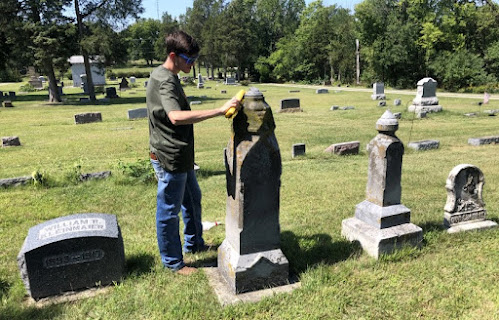Tips and Tricks - Cleaning headstones is an important part of preserving the beauty and integrity of these historical markers. Whether you are a caretaker of a cemetery or have a loved one buried there, knowing how to properly clean headstones is crucial.
In this article, we will guide you through the process of cleaning headstones effectively and safely.
1. Understanding the Headstone Material
Before you start cleaning a headstone, it's essential to understand the material it is made of. Headstones can be made from various materials such as granite, marble, limestone, or bronze. Different materials require different cleaning methods and products to avoid damage.
1.1 Granite Headstones
Granite headstones are durable and commonly used. To clean a granite headstone, use a soft-bristle brush and a non-ionic detergent mixed with water. Avoid using acidic or abrasive cleaners as they can cause damage.
1.2 Marble Headstones
Marble headstones are more delicate and prone to erosion. Clean marble headstones with a soft brush and a mild, non-ionic detergent mixed with water. Avoid using acidic or abrasive cleaners, as they can etch the surface of the marble.
2. Gathering the Cleaning Supplies
To clean headstones effectively, gather the necessary cleaning supplies. You will need:
- A soft-bristle brush
- A non-ionic detergent
- Distilled water
- A plastic scraper
- Cotton swabs
- A bucket
- Gloves
- Protective goggles
- Soft cloths or sponges
3. Preparing the Headstone
Before applying any cleaning solution, gently remove loose debris and dirt from the headstone using a soft brush or cloth. This step helps prevent scratching during the cleaning process.
4. Cleaning the Headstone
Dilute the non-ionic detergent in a bucket of distilled water according to the manufacturer's instructions. Wet the headstone with clean water, and then apply the detergent solution using a soft brush or sponge. Scrub gently in a circular motion, paying attention to stained or soiled areas.
For stubborn stains, use a plastic scraper or a cotton swab soaked in the cleaning solution. Be cautious not to scratch or damage the surface of the headstone. Rinse the headstone thoroughly with clean water, ensuring all traces of the detergent are removed.
5. Drying and Protecting the Headstone
After cleaning, use soft cloths or sponges to pat the headstone dry gently. Avoid rubbing, as it can cause friction and potential damage. Let the headstone air dry completely before applying any protective sealants or coatings.
6. Applying Sealants or Coatings (If Necessary)
Applying a sealant or coating to the headstone can provide extra protection against weathering and staining. However, not all headstones require sealants, so it's crucial to consult with a professional or refer to the manufacturer's guidelines before applying any products. If you decide to apply a sealant or coating, choose one specifically designed for the type of headstone material you are working with. Follow the instructions carefully and apply it evenly using a soft brush or cloth. Allow the sealant to dry completely before touching or exposing it to moisture.
7. Regular Maintenance
To keep headstones looking their best, regular maintenance is essential. Here are some tips for ongoing care:
- Regularly remove debris and dirt using a soft brush or cloth.
- Wash the headstone with water at least once a year to remove surface buildup.
- Avoid using harsh chemicals, acidic cleaners, or abrasive tools.
- Monitor for any signs of damage or deterioration and take appropriate action.
8. Seeking Professional Assistance
If you are unsure about cleaning or maintaining a headstone, it's always best to seek professional assistance. There are experts who specialize in headstone restoration and preservation, and they can provide valuable guidance and services to ensure the longevity of the memorial.
Conclusion
Cleaning headstones is a task that requires careful attention and knowledge of the appropriate methods and products. By understanding the material, gathering the necessary supplies, and following proper cleaning techniques, you can effectively clean and preserve headstones for years to come. Remember to always prioritize the gentle treatment of headstones to avoid causing any damage.
Frequently Asked Questions
1. Can I use bleach to clean headstones?
It is not recommended to use bleach or other harsh chemicals on headstones, as they can cause discoloration and damage to the surface. Stick to non-ionic detergents and mild cleaning solutions specifically formulated for headstone materials.
2. How often should I clean a headstone?
Regular cleaning is beneficial to maintain the appearance and integrity of a headstone. Aim to clean the headstone at least once a year, or more frequently if you notice significant buildup or staining.
3. Is it necessary to apply a sealant to the headstone?
Applying a sealant or coating is not always necessary, and it depends on the material and condition of the headstone. Consulting with a professional or referring to the manufacturer's guidelines can help determine if a sealant is recommended for your specific headstone.
4. How can I remove moss or algae from a headstone?
Moss or algae can be gently removed from a headstone using a soft brush or cloth soaked in a mild cleaning solution. Avoid using excessive force or scraping, as it can damage the surface. If the growth is persistent, consider seeking professional assistance.
5. Are there any special considerations for cleaning bronze headstones?
Bronze headstones require specific care to prevent tarnishing. Clean them using a non-ionic detergent mixed with water and a soft brush. Avoid abrasive cleaners or scrubbing tools that can scratch the bronze surface. Applying a protective wax or polish can help maintain the bronze's luster.
